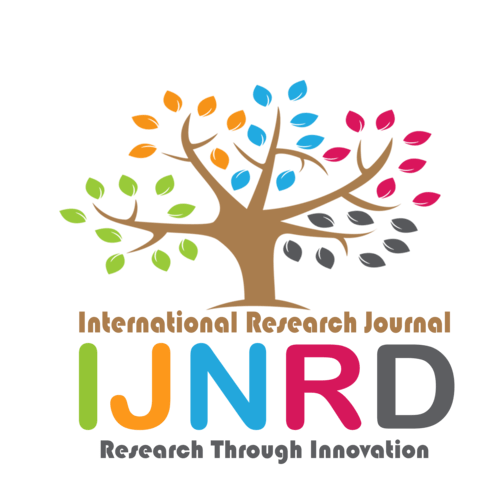|
|||||||||||||||

|
INTERNATIONAL JOURNAL OF NOVEL RESEARCH AND DEVELOPMENT International Peer Reviewed & Refereed Journals, Open Access Journal ISSN Approved Journal No: 2456-4184 | Impact factor: 8.76 | ESTD Year: 2016 Scholarly open access journals, Peer-reviewed, and Refereed Journals, Impact factor 8.76 (Calculate by google scholar and Semantic Scholar | AI-Powered Research Tool) , Multidisciplinary, Monthly, Indexing in all major database & Metadata, Citation Generator, Digital Object Identifier(DOI) |
||||||||||||||
Issue: May 2024
Volume 9 | Issue 5
Review Result and Publication of Paper within : 2-3 days
Click Here For more DetailsFor Authors
Forms / Download
Published Issue Details
Editorial Board
Other IMP Links
Facts & Figure
Impact Factor : 8.76
Issue per Year : 12
Volume Published : 9
Issue Published : 96
Article Submitted :
Article Published :
Total Authors :
Total Reviewer :
Total Countries :
Indexing Partner
Join RMS/Earn 300
Licence
This work is licensed under a Creative Commons Attribution-NonCommercial 4.0 International License







|
Published Paper Details
|
|
| Paper Title: | Illegal immigrants in Northeast Region of India |
| Authors Name: | Tejkeshwore Moirangthem , Diksha Jha |
| Download E-Certificate: | Download |
| Author Reg. ID: |
IJNRD_194400
|
| Published Paper Id: | IJNRD2305197 |
| Published In: | Volume 8 Issue 5, May-2023 |
| DOI: | |
| Abstract: | An illegal migrant in India is an outsider who has entered India either without legitimate records or who at first had a substantial report, however has exceeded past the allowed time, according to the general arrangements of the Citizenship Go about as corrected in 2003. Such people are not qualified for citizenship by enrollment or naturalisation.They are likewise obligated to be detained for 2-8 years and fined. The minority groups of Bangladesh, Pakistan, and Afghanistan that were forced to seek refuge in India because of religious persecution or fear of religious persecution were granted an exception in 2015. They aren't considered undocumented immigrants, therefore they can still apply for citizenship. The 2001 Indian Census provides data on migrants, though not just illegal immigrants. According to the 2001 Census, Pakistanis and Bangladeshis make up the majority of immigrants in India. It is crucial to stop illegal immigrants from entering India because they put strain on locals and provide a security risk, particularly in sensitive areas like Jammu and West Bengal. The Indian security establishments, for instance, claimed that some Rohingyas sympathising with many militant group's ideologies may be active in Jammu, Delhi, Hyderabad, and Mewat and can be a potential threat to internal security. Legal immigrants in India are not considered refugees. Since India did not ratify the 1951 Refugee Convention,the non-refoulement and impediment to expulsion principles of the UN do not apply in India. If an illegal immigrant does not meet the host country's legal definition of a legitimate refugee, they are not given an impediment to expulsion.Illegal immigrants are those who enter a nation in contravention of its immigration laws or those who remain there after being denied legal permission to do so. Illegal immigration typically moves upward in terms of wealth, from poorer to richer nations. The Supreme Court of India overturned the unlawful Migrants (Determination by Tribunal) Act, 1983 in 2005, stating that it "has created the biggest hurdle and is the main impediment or barrier in the identification and deportation of illegal migrants." During a Supreme Court hearing on a public interest litigation petition for the deportation of illegal migrants on August 9, 2012, it was stated that the Indian government's policy does not support any type of illegal migration, either into its territory or the illegal immigration of its citizens, and that the government is committed to deporting illegal Bangladeshi migrants, but only in accordance with the law. In the past, the Indian government has recognised immigrants from Tibet and Sri Lanka as refugees, giving the former free education and some form of identification. By amending the Citizenship Act of 1955, the Citizenship Amendment Act of 2019 made it possible for immigrants from minority communities—including Hindus, Sikhs, Buddhists, Jains, Christians, and Parsis—who fled religious persecution in Afghanistan, Bangladesh, and Pakistan to obtain Indian citizenship as long as they arrived on or before December 31, 2014— while excluding members of the Muslim community, which makes up the majority in those countries. |
| Keywords: | |
| Cite Article: | "Illegal immigrants in Northeast Region of India", International Journal of Novel Research and Development (www.ijnrd.org), ISSN:2456-4184, Vol.8, Issue 5, page no.b732-b744, May-2023, Available :http://www.ijnrd.org/papers/IJNRD2305197.pdf |
| Downloads: | 000118749 |
| ISSN: |
2456-4184 | IMPACT FACTOR: 8.76 Calculated By Google Scholar| ESTD YEAR: 2016 An International Scholarly Open Access Journal, Peer-Reviewed, Refereed Journal Impact Factor 8.76 Calculate by Google Scholar and Semantic Scholar | AI-Powered Research Tool, Multidisciplinary, Monthly, Multilanguage Journal Indexing in All Major Database & Metadata, Citation Generator |
| Publication Details: |
Published Paper ID:IJNRD2305197 Registration ID: 194400 Published In: Volume 8 Issue 5, May-2023 DOI (Digital Object Identifier): Page No: b732-b744 Country: Gautam Buddh Nagar, Uttar Pradesh , India Research Area: Arts Publisher : IJ Publication Published Paper URL : https://www.ijnrd.org/viewpaperforall?paper=IJNRD2305197 Published Paper PDF: https://www.ijnrd.org/papers/IJNRD2305197 |
| Share Article: | |
|
Click Here to Download This Article |
|
| Article Preview | |
|
|
|
Major Indexing from www.ijnrd.org
| Semantic Scholar | Microsaoft Academic | ORCID | Zenodo |
| Google Scholar | ResearcherID Thomson Reuters | Mendeley : reference manager | Academia.edu |
| arXiv.org : cornell university library | Research Gate | CiteSeerX | PUBLON |
| DRJI | SSRN | Scribd | DocStoc |
ISSN Details
 |
 |
ISSN: 2456-4184
Impact Factor: 8.76 and ISSN APPROVED
Journal Starting Year (ESTD) : 2016
DOI (A digital object identifier)
Conference
Open Access License Policy
Important Details
Social Media
| Copyright © 2024 - All Rights Reserved - IJNRD |












Facebook Twitter Instagram LinkedIn